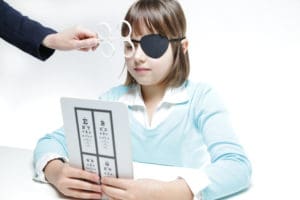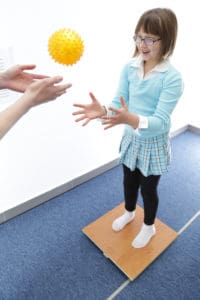At-Home Vision Therapy: How to Do It Effectively
Home / How to Improve Your Eyesight Naturally /
Last Updated:
At-home vision therapy is a therapy type that acts as brain and eye physical therapy. It is a non-surgical treatment that eye doctors can use to treat many common visual issues.
Table of Contents
It is an option for children and adults, but it is most often used for children. In addition to vision problems, this therapy may benefit learning disabilities too.
This therapy is progressive and involves the use of various procedures and exercises. While most elements are done at home, there are some procedures or exercises that doctors might do in their office one to two times a week.
This therapy might involve the use of different medical and/or specialized equipment. This may include things like corrective lenses, computer software, or eye patches.
A comprehensive vision examination is the first step. This allows doctors and patients to see which at-home therapies will be the most beneficial.

This therapy is not defined by techniques and tools. Successful outcomes occur as a result of a therapeutic process that requires a collaborative effort between the prescribing doctor, the patient, the vision therapist, and the patient’s parents (for pediatric patients).
The goal of this therapy is to treat vision issues that contact lenses, eyeglasses, and surgery cannot fix on their own. The goal is to help the patient to achieve comfortable, clear binocular vision.
Why Is At-Home Vision Therapy Used?
Vision therapy works to improve or correct specific visual system dysfunctions. Examples include strabismus, accommodation, visual-perceptual motor disabilities, convergence or binocular vision dysfunctions, ocular motor function disabilities, and amblyopia.
Doctors will use a comprehensive diagnostic process to evaluate your vision system. This allows them to craft a tailored treatment plan focused on your specific vision system dysfunctions.
You deserve clear vision. We can help.
With 135+ locations and over 2.5 million procedures performed, our board-certified eye surgeons deliver results you can trust. Your journey to better vision starts here.
Symptoms of Vision Problems
Several symptoms can occur when someone has vision problems. These signs and symptoms may include the following:
- Eye pain
- Flashes of light
- Halos or rainbows around lights
- The appearance of a curtain coming down over an eye
- Light sensitivity
- Eye color changes
- Persistent floaters that develop suddenly
- Blurry, hazy, or double vision
- Sudden bright floating spots
- Seeing floating spider webs
- Sensing ink filling a cup in one of your eyes
- Red, swollen eyes
- Pupil developing white spots
- Burning, itching or heavy discharge
- Sudden vision changes
The exact symptoms a person experiences depends on the vision issue they have developed. Poor vision can also affect people in other ways. These may include:
- Double or blurry vision. The edges of objects may lose their definition.
- Fatigue and discomfort. Vision problems may make people excessively tired following work or school.
- These can happen in the temples or across the brow.
- Erratic or poor performance. This may include misjudging when trying to catch something, losing your place when you read, reading very slowly, or not remembering what you are reading.
- This issue describes the brain trying to reduce double vision by ignoring information from one eye.
Pediatric and Adult Vision Examinations

To determine the type of at-home vision therapy necessary, you have to undergo a vision examination. There are some differences between pediatric and adult exams.
Eye exams for children are important because they can detect issues that could potentially interfere with your child’s safety and school performance. It is estimated that in the United States, about 35 percent of preschool students have farsightedness, nearsightedness, or astigmatism.
Kids should have their first comprehensive exam at 6 months old. The eye doctor will tell parents when all follow-up exams should be done. At 6 months old, the following tests are common:
- Fixate and follow: This test will see if your baby’s eyes can focus on light or an object as it moves.
- Tests of pupil responses: With the absence or presence of light, this test shows whether the pupils close and open properly.
- Preferential looking: This test replaces a typical eye chart to assess the baby’s vision capabilities.
Once kids get older, there are other tests that are used to detect a child’s visual health.
- Retinoscopy: This test allows the doctor to look at the reflection from the retina by using light. It helps doctors to prescribe the right eyeglass strength.
- LEA symbols: This test is used in place of the Snellen chart for kids who are too young to know numbers and letters.
- Random dot stereopsis: This testing uses 3D glasses and special dot patterns to see how well the child’s eyes work together.
For adolescents, teens, and adults, there are other tests a doctor can do to evaluate visual health.
- Visual acuity testing: For this test, you will read the different letters on the Snellen chart to evaluate your vision.
- Eye muscle test: This test allows your doctor to evaluate your eye muscles to see how much control they have.
- Refraction assessment: Bent light waves are passed through your lens and cornea for this test. If they do not perfectly focus on your retina, this indicates a refractive error.
- Color vision testing: You will look at multiple dot-pattern tests that are various colors to see if you can discern them.
- Visual field test: This test evaluates how much you can see sideways without moving the eyes to examine your total field of vision. There are different tests the doctor might perform, including the tangent screen exam, confrontation exam, or automated perimetry.
- Retinal examination: This test will evaluate the health of your optic disk, retina, and the retina’s blood vessels.
- Slit-lamp examination: This test examines the eyelids, cornea, lens, lashes, iris, and the fluid chamber between the iris and cornea. A dye may be used.
Types of At-Home Vision Therapy
The vision health issue a person has will determine the vision therapy that will be most beneficial. The following are possible therapies and techniques:
- Virtual reality technology to treat strabismus
- Vision therapy software to enhance visual skills
- Prescription eyedrops to improve eye comfort
- Visual lifestyle recommendations to improve visual function
- Shaw lenses to help the eyes to work together (ideal for severe amblyopia cases)
- Contact lenses to improve visual acuity
- Occlusion using a patch on one eye to protect it or strengthen the opposite eye
- Wolff wand therapy to improve eye control
- Hart charts to improve eye movement, accommodation, and visual attention
- Marsden balls to improve visual attention
- Balance boards to evaluate how the eyes and body are working together
- Tabletop rotator to ensure that a person’s eye movements are efficient enough for reading
- Yoked prism to help people reorient their visual system (ideal for traumatic brain injuries, developmental delays, and autism)
- Various computer programs to help people with visual elements, such as vergence, eye movements, accommodation, and visual information processing

Your doctor might recommend one therapy or a combination of these therapies for you or your child for the following reasons:
- To treat an existing vision problem
- To prevent certain vision problems
- To improve the comfort or efficiency of your vision
Devices Used
There are multiple devices that doctors might recommend as part of vision therapy.
- Corrective lenses
- Prism lenses
- Eye patches or occluders
- Computer software
- Devices for visual-motor-sensory integration training
- Therapeutic lenses
- Optical filters
- Electronic targets that feature timing mechanisms
- Balance boards
You deserve clear vision. We can help.
With 135+ locations and over 2.5 million procedures performed, our board-certified eye surgeons deliver results you can trust. Your journey to better vision starts here.
Conditions Vision Therapy May Treat
There are several reasons why a doctor might recommend vision therapy. Conditions may include:
- The magnitude, frequency, and direction of the person’s eye turn will determine how effective vision therapy is for this condition. Strabismus is characterized by not being able to maintain proper eye alignment.
- Eye movement disorders. Problems with eye movements can make it difficult to perform up-close work or read. Vision therapy may improve eye movement accuracy.
- This condition is also called a lazy eye. Vision therapy may help people to achieve normal visual acuity in the affected eye.
- Other binocular vision problems. Phorias cause subtle eye alignment issues. These problems can result in eye fatigue and strain when you are trying to read. Vision therapy can correct or minimize this issue.
- Accommodative disorders. Vision training may be beneficial for helping people to improve their near-far focusing skills.
- Other issues. Some vision issues are associated with an acquired brain injury or a developmental disability.
Using the Therapies Safely and Effectively

This therapy is usually tailored to the individual, so it targets your specific needs. Proper use of any devices and techniques help to ensure the effectiveness and safety of each of the therapies.
It is important to follow the instructions for each therapy exactly. Use all devices per the prescribing doctor’s instructions. If there is ever any question about proper use, talk to the doctor before you start using a device or technique.
How Long Do the Results Take?
There is no exact timeframe for how quickly you or your child will notice results from vision therapy. Each program is tailored to the person and their exact vision issues.
Therapy programs can range from three months to two years, depending on the person’s needs. Since this therapy is progressive, the results build over time.
Once someone achieves their goals, they may need to perform some maintenance therapy to sustain their results. This is typically necessary when vision therapy was used for amblyopia, strabismus, or a traumatic brain injury.
At-home vision therapy can be helpful for both adults and children. A comprehensive eye examination is the first step to determine which therapies may benefit you the most.
As adults or children continue with their therapy, they will usually see their doctor for periodic evaluations. This will confirm they are properly implementing the therapies and that the therapies are working as intended.
How Much Does At-Home Vision Therapy Cost?
There are multiple costs associated with at-home vision therapy.
First, you will need to undergo an initial assessment, which often costs several hundred dollars. Some practitioners offer a free consultation appointment, but this does not always mean that they do not require an assessment appointment as well.
Then comes the cost of the therapy itself. Vision therapy is usually billed by appointment, and each of these can cost anywhere from a little over $100 to several hundred dollars.
Some practices may also charge a fee for equipment rentals depending on the tools you will need for your therapy. These costs are sometimes refunded when the equipment is returned.
For example, the Vision Therapy Center in Wisconsin charges between $220 and $350 for an initial assessment depending on what eye conditions you have. After that, therapy is billed at $152 a visit. The Center estimates that most patients will pay a total of between $1,000 and $7,000 for treatment.
On the other hand, the Vision Therapy program at the University of California Berkeley’s School of Optometry offers patients 8 blocks of therapy at $810 a session ($6,480 total). They also charge an additional $146 for equipment, $50 of which is credited back to the patient after the equipment is returned after all eight therapy blocks are completed.
Will My Insurance Cover It?
Getting insurance coverage for vision therapy can be difficult. This is because there is no consensus on whether the procedure should be covered by vision insurance or health insurance. Depending on what policy you have, vision therapy may not be covered by either type of plan.
Even if you are covered, that coverage may be limited. Sometimes an insurance company will pay for the initial consultation but not for the therapy appointments after that.
Often, the decision about whether an insurance company will cover vision therapy comes down to whether it has been deemed medically necessary (the least expensive way to maintain a person’s quality of life and ability to function). This is how Medicare and Medicaid make decisions regarding vision therapy coverage.
If your insurance company does not agree that vision therapy is medically necessary in your case, you can ask your doctor to help you appeal their decision. This may not work, but it is worth a try.
You deserve clear vision. We can help.
With 135+ locations and over 2.5 million procedures performed, our board-certified eye surgeons deliver results you can trust. Your journey to better vision starts here.
References
- Signs and Symptoms of Vision Problems. American Foundation for the Blind VisionAware.
- Eye Exams for Children. All About Vision.
- Eye Exam. Mayo Clinic.
- Vision Therapy Explained. Australasian College of Behavioural Optometrists.
- Vision Therapy: A Top 10 Must-Have List. (August 1, 2014). Optometry Times.
- Vision Therapy for Children. All About Vision.
- What Is Vision Therapy or Visual Training? Optometrists Network.
- Vision Therapy and Neuro-Rehabilitation: Optometric Considerations in Third Party Reimbursement. (2019). American Optometric Association.
- Testing and Treatment Costs for Vision Therapy. (2021). The Vision Therapy Center.
- Vision Therapy Program. (2021). University of California Berkeley School of Optometry.
This content is for informational purposes only. It may have been reviewed by a licensed physician, but is not intended to serve as a substitute for professional medical advice. Always consult your healthcare provider with any health concerns. For more, read our Privacy Policy and Editorial Policy.